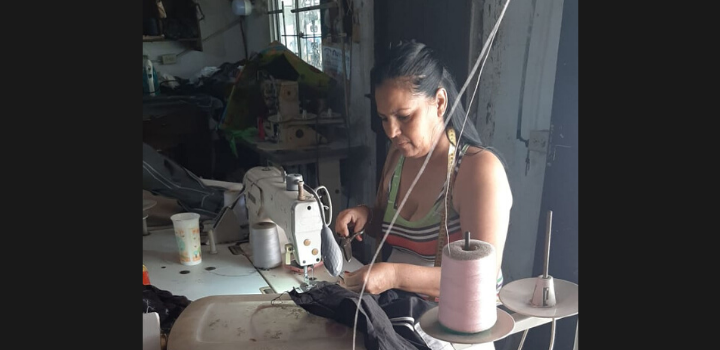This post was cross-posted on Medium.
Gender-based violence (GBV) is rampant — globally, one in three women experiences sexual and physical violence and abuse. It is pervasive in humanitarian settings before, during, and after crises. GBV is underreported by survivors and individuals at risk, due, among other factors, to stigma, fear of reprisal, and inadequate support services.
A recent pilot project undertaken by the Women’s Refugee Commission (WRC) and CARE in Ecuador shows that giving women cash and vouchers as part of a program to prevent and respond to GBV can be highly effective and yield positive impacts in the lives of GBV survivors and individuals at risk of GBV.
How can transferring cash or vouchers to refugees, internally displaced individuals, and migrants help prevent and respond to GBV? Cash and voucher assistance (CVA) enable people to make their own choices about goods and services. CVA can play an important role in preventing and responding to GBV — for example, helping to address economic drivers related to early marriage or support GBV survivors to afford essential health or legal services.
However, while the use of CVA to deliver humanitarian assistance has grown significantly in the past decade, it is rarely used in programs to prevent and respond to GBV.
In WRC and CARE’s three-month pilot in Ecuador, 100 Venezuelan migrants living in El Oro Province participated in GBV services that had a CVA component. WRC and CARE provided technical support, and the project was implemented by CARE Ecuador and local partners Fundación Quimera (FQ) and The Latin American Platform of Sex Workers (PLAPERTS). Two key humanitarian field resources were adapted for use in this context: WRC’s Toolkit on Cash and GBV and the CVA and GBV Compendium.
In El Oro, GBV case managers assessed whether CVA could support action plans to protect migrants at risk of GBV and support survivors in their recovery, for example, by helping them afford essential health or legal services. One hundred out of 120 migrants’ cases reviewed by case managers indicated a need for CVA to help support protection from GBV.
Each selected participant received US$100 via cardless ATMs. They were followed closely to monitor and ensure their safe access to and use of cash transfers, and ensure that transfers did not expose them to further harm.
During case intake, GBV case managers identified potential ways cash transfers could be used to protect participants from GBV, including:
- improved participation by participants in household decision-making;
- increased asset ownership and control over resources;
- improved access to response and recovery services for GBV survivors; and
- access to psychological/mental health services and a reduced reliance on risky coping strategies, such as sex work.
However, the impact of CVA on GBV — based on post-distribution monitoring data — was broader than these initial intended outcomes and included:
- reduced intimate partner violence; and
- reduced exposure to sexual exploitation and abuse.
During a review led by CARE after the pilot, partners identified successes and key opportunities to improve this approach. Participants in the review were overall positive about the experience. They reported:
- Strong partnerships were established among organizations with complementary expertise.
- Knowledge and skills were exchanged, breaking GBV and CVA staff out of siloes and giving CVA staff the opportunity to be trained in an approach that focuses on survivors. Host community GBV service provider staff received training on serving crisis-affected populations.
- Support to GBV survivors and individuals at risk of GBV was comprehensive, resulted in positive outcomes enhancing protection from GBV, and was met with high levels of satisfaction among clients.
- The cardless ATM was used for one of the first times in Ecuador and proved to be a successful delivery mechanism.
The project was a learning experience and the teams found opportunities for improvement, including:
- Higher transfer values and differentiated transfer values should be tailored for participants’ need over a longer duration, with a longer period of accompaniment by GBV caseworkers.
- Migrants and host Ecuadorians should be targeted to ensure that the most marginalized across both populations have access to improved services and to reduce risks of social tension.
- CVA assistance for GBV survivors and individuals at risk should be linked to livelihoods opportunities to ensure sustainable outcomes.
To undertake the broad integration of CVA and GBV, the humanitarian community must:
- build the capacity of humanitarian responders and non-traditional partners;
- address key evidence gaps, including through impact evaluations; and
- advocate with donors to consider the start-up costs and funding levels associated with integrating CVA within GBV case management, as well as time required for optimal impact for crisis-affected populations.
It is clear that CVA, while not always appropriate, can play a key role in the prevention of and response to GBV. Every tool at humanitarians’ disposal is needed and should be used to support those at risk of GBV and survivors. CVA must be in play, where it fits, as in Ecuador, where plans are underway to expand the approach in El Oro, as well as to replicate the approach in other humanitarian settings, including in the north of Ecuador and elsewhere in the region.
The Ecuador pilot was funded by Sweden’s Ministry for Foreign Affairs under the Call to Action on Protection from GBV in Emergencies.
For more information on the pilot, see the learning brief (available in English, Spanish, French, and Arabic) and practical field guidance and tools on integrating CVA and GBV on WRC’s website.


